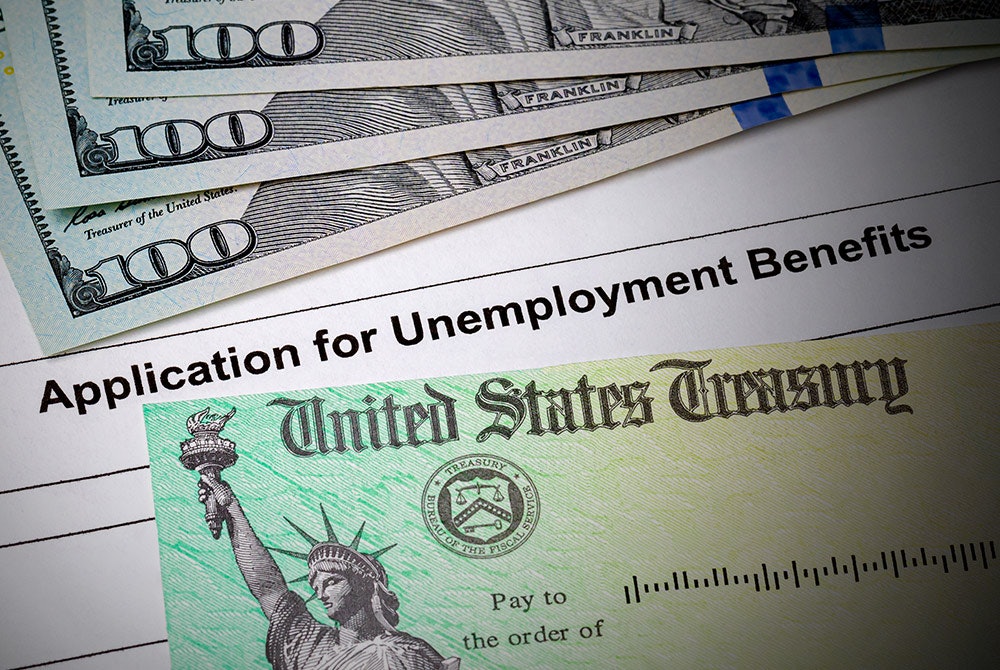- How Unemployment Fraud Works
- Red Flags of Unemployment Fraud
- How to Beat Unemployment Fraud and Identity Theft
- Fallen for Unemployment Identity Theft?
- Frequently Asked Questions
The crux of unemployment fraud involves a scammer using your personal information to claim unemployment benefits. This not only gives scammers access to money they aren’t legally entitled to but may cause complications for you at tax time or if you file your own unemployment claim.
Using information like your name, birth date, and Social Security number (SSN), scammers will masquerade as you on state-run unemployment sites, then collect the benefits doled out in your name.
How Unemployment Fraud Works
There are many ways a scammer may steal your details, which can then be used for unemployment identity theft. But one of the most sinister scams involves the act of applying for unemployment itself. Here's how this scam works.
You Receive a Message From Your State Workforce Agency
You receive an email or text message from what looks like your state workforce agency (SWA). The message includes a link where you’re told you can file your unemployment claim.
Example EmailYou received this email from the Department of Workforce Development because we need you to verify your identity.
This is a result of your recent eligibility for unemployment benefits. To activate your unemployment benefits, please verify your identity by clicking the link below.
You Enter Your Personal Information Online
Once you click on the link, you’re taken to a website that looks like the SWA site. You may be asked to create a username and password or PIN before being able to fill out a form to file your claim.
Questions on the form ask for personal information like your Social Security number (SSN) and bank account details, which may not ring any alarm bells since you’re under the impression that it’s a legitimate government website.
You’re Told Your Claim Is Denied
Several days or weeks after you send in your information, you may receive a further message explaining that your claim has been denied. This may keep you from reaching out to the real state workforce agency if you don’t receive any money.
Your Identity Is Used to File Unemployment Claims
Meanwhile, the scammer uses your information to file a claim in your name on the real SWA site.
With your information, the scammer collects government money in your name, and your data can also be used for any number of other scams.
Unemployment identity theft can affect you in two main ways:
- The SWA may deny your genuine claim for unemployment benefits
- You’ll run into complications come tax return time, resulting in possibly being penalized or owing more tax than you should
Red Flags of Unemployment Fraud
The government tends to scrub any examples of unemployment fraud from the internet to discourage copycats, so it can be hard to know exactly what to look for in a scam. Still, there are some signs to look out for that may indicate whether you’re being targeted by unemployment identity theft scammers, including:
- Receiving mail from a government agency about an unemployment claim you did not file.
- Receiving a 1099-G tax form in the mail reflecting unemployment benefits you weren’t expecting.
- The form may come from a state in which you do not live or did not file from.
- Box 1 on the form will show your current amount of unemployment compensation.
- Hearing from your employer that an unemployment claim has been filed in your name.
If you experience any of the above, your information may have been used to file an identity theft unemployment claim.
Examples of Identity Theft Due to Unemployment Fraud
In this first example, a Virginia woman's benefits suddenly stopped coming. Only after contacting the state department did she find out that scammers had managed to access her benefits account and changed her bank account information where deposits were being made.
In another example, authorities uncovered an unemployment ring in California that applied for more than 1,000 bogus unemployment claims. Their victims were left with frozen accounts and no unemployment checks.
How to Beat Unemployment Fraud and Identity Theft
When attempting to avoid fake unemployment scams, it’s essential to keep a few facts in mind:
- A real SWA will never contact you through unsolicited emails or texts.
- SWAs do not use email or text to invite people to apply for benefits.
- If you’ve applied for unemployment benefits and receive a text or email, contact your SWA directly rather than clicking on any link.
What To Do If you Receive a Suspicious Email or Text
If you receive an email or text with a link to a purported SWA site, you can further investigate by:
- Examining the URL. Make sure it’s for an official SWA site.
- Hovering your cursor above the link will let you see the genuine URL without clicking on it.
- Scammers can manipulate the names of links to make them look more official.
- Examining the email address. Make sure it’s from a .gov account.
- Looking out for poor grammar, spelling errors, and strange phrases.
- Paying attention to website details, including:
- Fonts
- Colors
- Logos
Unfortunately, there are several ways a scammer may come across your information, and you can become the victim of unemployment identity theft without even encountering one of these links.
It's a good idea to stay vigilant when dealing with unemployment benefits and always make sure you trust your gut. If something seems off, click off of the website, hang up the phone, or delete a suspicious email immediately.
Fallen for Unemployment Identity Theft?
Identity theft is already a serious crime, and using someone else’s identity to commit unemployment fraud is even more severe. If you've fallen for unemployment fraud and feel like your identity may be in jeopardy, there are a few things you can do.
Report Unemployment Fraud
If you believe you’re the victim of unemployment identity theft, you should:
- Report the fraud in the state where it occurred.
- The state may require further documentation to open an investigation, including:
- Copies of a police report.
- A sworn affidavit.
- The state may require further documentation to open an investigation, including:
- Report the incident to the National Center for Disaster Fraud.
- Request a corrected 1099-G form from the SWA.
- You don’t have to wait for this form to file taxes.
- Do NOT report the incorrect 1099-G form on your tax return.
- If you already filed taxes, you do not need to file an amended return.
You may also want to create an IRS Identity Protection PIN. This is a six-digit code that will help protect your federal tax filings from identity theft if you’ve experienced unemployment fraud.
Recover from Identity Theft
To recover from identity theft, you should:
- Report the incident to the:
- Contact your bank and credit card companies about the incident.
- Cancel your current credit and debit cards and open new ones.
- Change your passwords and PINs.
- Place a fraud alert on your credit report.
Being the victim of unemployment identity theft can be a serious and stressful situation. It’s essential to remain calm and as vigilant as possible to ensure scammers don’t walk away with any more of your money—or identity.


Comments